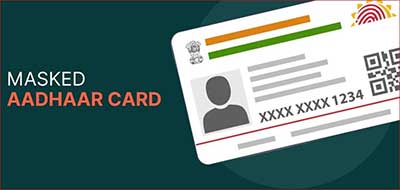Relevance: GS-3: Indian Economy and issues relating to planning, mobilization, of resources, growth, development, Inclusive growth and issues arising from it.
Key Phrases: The Unique Identification Development Authority of India, Unique Identification Numbers, User Licence, masked Aadhaar card, Know Your Customer, CIDR
Context:
- Two days after issuing an advisory asking people to refrain from sharing photocopies of their Aadhaar Card, the Unique Identification Development Authority of India (UIDAI) opted to withdraw the notification.
Note:-
- The Unique Identification Authority of India, or UIDAI, is a government agency responsible for issuing Unique Identification Numbers (UIDs), often known as 'Aadhaar,' to all Indian citizens.
What did the UIDAI Advisory Say?
- The withdrawn notice had suggested holders use a masked Aadhaar card instead of the conventional photocopy, adding that the document must not be downloaded from a cybercafé or public computer and if done for some reason, must be permanently deleted from the system.
- The notice informed that only entities possessing a ‘User Licence’ are permitted to seek Aadhaar for authentication purposes.
- Private entities like hotels or film halls cannot collect or keep copies of the identification document.
What does the Law Say?
- The Aadhaar (Targeted Delivery of Financial and Other Subsidies Benefits and Services) Act, 2016 makes it clear that Aadhaar authentication is necessary for availing subsidies, benefits and services that are financed from the Consolidated Fund of India.
- In the absence of Aadhaar, the individual is to be offered an alternate and viable means of identification to ensure she/he is not deprived of the same.
- Separately, Aadhaar has been described as a preferred KYC (Know Your Customer) document but not mandatory for opening bank accounts, acquiring a new SIM or school admissions.
- The requesting entity would have to obtain the consent of the individual before collecting his/her identity and ensure that the information is only used for authentication purposes on the Central Identities Data Repository (CIDR).
- The regulator does not receive or collect the holder’s bank, investment or insurance details.
- Additionally, the Aadhaar Act forbids sharing Core Biometric Information (such as finger print, iris scan, among other biometric attributes) for any purpose other than Aadhaar number generation and authentication.
- The Act makes it clear that confidentiality needs to be maintained and the authenticated information cannot be used for anything other than the specified purpose.
- No Aadhaar number (or enclosed personal information) collected from the holder can be published, displayed or posted publicly.
- Identity information or authentication records would only be liable to be produced pursuant to an order of the High Court or Supreme Court, or by someone of the Secretary rank or above in the interest of national security.
What is a Masked Aadhaar?
- It is an offline verification system provided by the Unique Identification Authority of India (UIDAI) to keep Aadhaar data private and secure.
- Aadhaar holders can download it from the UIDAI portal.
- It will show only the name, address, photo and a virtual id, while masking the first eight digits of the Aadhaar number with special characters like “xxxx-xxxx”.
Importance of Masked Aadhar Card:
- Since it just reveals the last four digits of your Aadhaar, users can share their Masked Aadhaar for eKYC in areas where revealing the whole Aadhaar number is not required.
- To protect users from fraud, the first eight are masked by the security function.
- The disguised Aadhaar can be obtained via e-Aadhaar, which is a password-protected electronic duplicate of Aadhaar.
- The competent Authority of UIDAI has digitally signed these online copies. According to the Aadhaar Act, an e-Aadhaar is as valid as a physical copy of Aadhaar for all purposes.

Do you know?
- The first UID number or Aadhaar was issued to a resident of Nandurbar in Maharashtra in the year 2010.
- According to unofficial data, the percentage of users of masked Aadhaar is in single digits; 131.68 crore Aadhaar cards are in use as on October 2021.
- e-Aadhaar is a password protected electronic copy of Aadhaar, which is digitally signed by the competent Authority of UIDAI and can be downloaded from the official website or mobile Application of the UIDAI.
- Virtual ID (VID) is a temporary, revocable 16-digit random number mapped with the Aadhaar number. VID can be used in lieu of Aadhaar number whenever authentication or e-KYC services are performed. Authentication may be performed using VID in a manner similar to using Aadhaar number. It is not possible to derive Aadhaar number from VID.
- While the masked Aadhaar option has been available for nearly five years now, not many know of it as the option pops up only when downloading the card.
- When downloaded at photocopy shops, internet cafes or stationery outlets — a widespread practice — the option is usually ignored by the operators.
The Structural Problems that the UIDAI Faces:
- Aadhar duplication: As per UIDAI’s Tech Centre, nearly 4.75 lakh duplicate Aadhaar numbers were cancelled as of November 2019.
- Not effective enough: The regulator relies on Automated Biometric Identification Systema for taking corrective actions which are not effective enough in detecting the leakages and plugging them.
- Worry for disabled: Biometric authentications can be a cause of worry, especially for disabled and senior citizens with both the iris and fingerprints dilapidating.
- Large population: UIDAI is dealing with the world’s second most populous country. As of March 2021, it had generated 129.04 crore Aadhaar numbers which covers 94% of the projected population.
Conclusion:
- Digital identity systems have the potential for both good and harm. A well-designed system, with adequate safeguards in place, can facilitate civic empowerment and inclusion, unlocking significant economic value.
- However, issues of privacy, user consent, biometrics and inclusion are still open for debate considering the implementation of such systems.
Source: The Hindu BL
Mains Question:
Q. What is a masked Aadhaar? Briefly discuss the structural problems that the UIDAI faces. (250 words).







